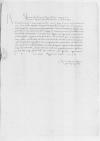Letter #2133
Sigismund I Jagiellon to Ioannes DANTISCUSCracow (Kraków), 1539-04-13
| received [1539]-04-26 Manuscript sources:
Auxiliary sources:
| ||||||||||
Text & apparatus & commentary Plain text Text & commentary Text & apparatus Excerpts concerning Dantiscus' travels
Reverendo in Christo Patri, domino
Reverende in Christo Pater, sincere nobis dilecte.
Cum et
Datum
Ad mandatum regiae maiestatis proprium

